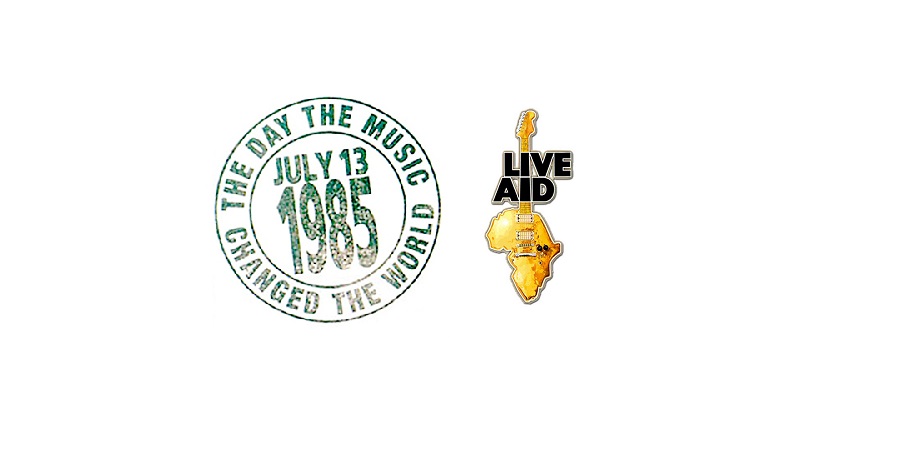On July 13, 1985, one of the most ambitious musical events in history took place. Live Aid, a dual benefit concert in London and Philadelphia, mobilised the international music world for the famine in Ethiopia. Forty years later, the event remains a benchmark for the power of music as a means of social change.
The story of Live Aid begins with Bob Geldof, frontman of The Boomtown Rats, who was shocked by BBC footage of the Ethiopian famine in October 1984. Within weeks, Geldof organised the supergroup Band Aid, which recorded the single “Do They Know It’s Christmas?”. The song, featuring voices including Boy George, George Michael, Sting and Bono, became the best-selling single of 1984 in the United Kingdom and inspired similar initiatives worldwide.
The success of Band Aid motivated Geldof to an even bigger project. Together with promoter Harvey Goldsmith, he developed the concept of simultaneous concerts on both sides of the Atlantic Ocean. London’s Wembley Stadium and Philadelphia’s John F. Kennedy Stadium were chosen as locations for what would grow into a 16-hour musical marathon.
Live Aid presented organisers with unprecedented challenges. Satellite technology had to ensure live broadcasting to an estimated 1.9 billion viewers in 150 countries. The BBC coordinated European broadcasts, while MTV and ABC provided American coverage. Techniques that now seem obvious were groundbreaking at the time. Artists performed largely for free, with only travel costs reimbursed. The short performances, usually limited to 15-20 minutes, forced acts to carefully select their setlists.
The London portion of Live Aid began with Status Quo, who set the tone with a cover of John Fogerty’s “Rockin’ All Over the World”. The British rock band showed themselves in top form, followed by Paul Weller’s The Style Council. Boomtown Rats, Geldof’s band, performed early with their hit “I Don’t Like Mondays”. Adam Ant presented songs from his album “Friend or Foe”, while Ultravox warmed up the audience for one of the day’s highlights.
Spandau Ballet performed “True”, followed by Dire Straits under Mark Knopfler’s leadership, delivering an impressive set including “Money for Nothing” and “Sultans of Swing”. Elvis Costello provided an emotional contribution with “All You Need Is Love”, followed by Nik Kershaw, who played “Wide Boy” and “The Riddle”. Sade brought a jazzy quality with “Your Love Is King”, while Sting combined his Police past with solo material.
The most acclaimed performance of Live Aid came from Queen, who took the stage at 18:41 London time. Freddie Mercury, Brian May, John Deacon, and Roger Taylor delivered a 20-minute set that is considered by many to be one of the best live performances ever. Their selection included “Bohemian Rhapsody”, “Radio Ga Ga”, “Hammer to Fall”, “Crazy Little Thing Called Love”, “We Will Rock You” and “We Are the Champions”. Mercury’s charisma and the band’s tight execution transformed the Wembley audience into a singing mass. The performance is often credited as the moment Queen’s career received new momentum.
David Bowie’s set in London included “TVC 15”, “Rebel Rebel” and “Modern Love”, with his theatrical presentation perfectly fitting the grand scale of the event. U2’s emotional version of “Bad” showed the band’s growing global status, with Bono drawing the audience in during an extended improvisation. The Who reunited for the occasion and played classics like “My Generation” and “Wont Get Fooled Again”.
The Philadelphia portion began at 13:51 local time with Joan Baez singing ‘Amazing Grace’. Bernard Watson and Hooters followed, after which The Four Tops represented the Motown sound. Billy Ocean brought ‘Caribbean Queen’ and ‘Loverboy’, while Black Sabbath delivered heavier work with Ozzy Osbourne. Run-DMC represented the emerging hip-hop culture, one of the few rap acts at the festival.
Rick Springfield played hits like ‘Jessie’s Girl’, followed by REO Speedwagon with ‘Can’t Fight This Feeling’. Crosby, Stills & Nash brought harmonious vocals with ‘Suite: Judy Blue Eyes’ and ‘Daylight Again’. Judas Priest brought heavy metal to Philadelphia with ‘Living After Midnight’ and ‘Breaking the Law’. Madonna performed controversially with ‘Holiday’ and ‘Into the Groove’, with her short set drawing mixed reactions.
A technical highlight was the live satellite connection between both locations. David Bowie in London appealed to the American audience, while The Who appeared via video from London on the Philadelphia screens. Phil Collins delivered a unique performance by performing in both cities, using the Concorde between London and New York.
The American portion culminated in a series of legendary performances. Santana brought Latin rock with ‘Right Now’, while Tom Petty and the Heartbreakers played ‘American Girl’ and ‘The Waiting’. Neil Young delivered a raw set with ‘Sugar Mountain’ and ‘Helpless’. The finale was provided by Mick Jagger via satellite from London for a duet with Tina Turner in Philadelphia on ‘State of Shock’. Bob Dylan performed with Keith Richards and Ronnie Wood of The Rolling Stones, with their version of ‘Blowin’ in the Wind’ emphasising the social consciousness of the event.
The Global Impact of Live Aid
Live Aid transformed how the world viewed benefit concerts and set a new standard for celebrity activism. The event generated approximately £127 million for famine relief in Africa, but the real impact extended far beyond financial contributions. For the first time in history, a musical event succeeded in drawing global attention to a humanitarian crisis on a scale that transcended political boundaries.
The social impact of Live Aid was unprecedented. The concept of a global community simultaneously watching the same event created a sense of collective engagement that was previously unthinkable. Families worldwide sat glued to their televisions for 16 hours, with national borders fading for a common purpose. This experience of worldwide solidarity would later be considered a precursor to the globalisation of media and consciousness.
Live Aid also fundamentally changed the relationship between popular culture and political engagement. Before 1985, celebrities who spoke out about world problems were often the subject of controversy. Live Aid legitimised the concept of celebrity activism and made it mainstream acceptable for entertainers to use their platform for social causes. This shift would influence generations of artists and lead to a culture where social engagement became an expected part of celebrity status.
The technological impact of Live Aid cannot be underestimated. The event pioneered the use of satellite technology for global broadcasting on a scale that made television history. The integration of live television, radio broadcasts and telephone donations created an interactive experience that was decades ahead of the digital media revolution. MTV’s wall-to-wall coverage introduced the concept of event television to a mainstream audience and established the music television channel as a serious media force.
The influence on the music industry was profound and lasting. Live Aid showed that music could be a powerful means of social mobilisation, leading to a wave of consciousness within the industry. Record companies began incorporating social responsibility into their business strategies, while artists became more aware of their potential role as social influencers. The event also created a new category of musical event: the mega-benefit, where multiple superstars collaborated for a higher purpose.
Live Aid also had significant consequences for the perception of Africa in the Western world. While the event was successful in drawing attention to the famine in Ethiopia, it also created a simplified narrative of Africa as a continent in need of help. This representation, though well-intentioned, contributed to stereotypes that still influence development aid and international relations decades later. Academics and activists would later criticise this approach, leading to more nuanced discussions about effective aid and the complexity of African problems.
Cultural Legacy and Lasting Influence
The cultural legacy of Live Aid extends far beyond the music world. The event became a reference point for collective action and showed that popular culture could be a catalyst for global awareness. This lesson would be applied to countless later campaigns, from environmental awareness to human rights, with the Live Aid model serving as a template.
The event inspired an entire generation of benefit concerts and social initiatives. Live 8 in 2005, organised by the same Bob Geldof, used the Live Aid model to pressure G8 leaders for debt relief in Africa. Farm Aid, founded by Willie Nelson, Neil Young and John Mellencamp, applied the concept to the American agricultural crisis. Rock in Rio integrated social messages into its festival format, while countless smaller benefit concerts worldwide imitated the Live Aid concept.
The documentation of Live Aid, including the four-part DVD release from 2004, preserves the performances for new generations and keeps the discussion about the role of music in social change alive. Streaming platforms have made classic moments accessible to millennials and Gen Z, with Queen’s performance maintaining particular popularity and regularly going viral on social media.
Live Aid’s influence on concert production and event management is equally lasting. The event set new standards for logistical coordination, satellite transmission and crowd management. The techniques developed for Live Aid are still used at major music events and sports broadcasts. The experience of organising simultaneous concerts on different continents provided valuable lessons for organising future mega-events.
In the years following Live Aid, academic criticism also emerged about the representation of Africa and the effectiveness of aid. Critics argued that the event reinforced Western superiority and ignored the structural causes of poverty. These discussions led to more nuanced approaches to celebrity activism and development aid, with greater recognition of the complexity of international problems.
Forty years after Live Aid, the event remains a source of inspiration for artists who want to use their platform for positive change. The legacy of July 13, 1985, lives on in every benefit concert, every charitable single and every attempt by musicians to put their art in service of a higher purpose. Live Aid proved that when music and good intentions come together, the world can listen and act. The event stands as a monument to the power of collective action and the enduring possibility of popular culture to bring about positive change in a world that constantly faces challenges.

